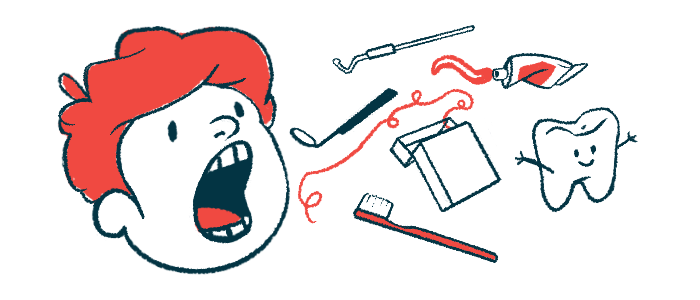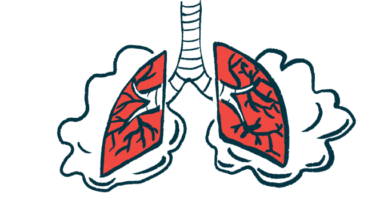Mouth opening unusually small in youngest SMA patients, study finds
Bulbar muscle weakness evident in infants, toddlers using 'child-friendly' scale

Bulbar muscles, those of the face and throat, are affected in spinal muscular atrophy (SMA), and researchers in Germany found that young children with SMA cannot open their mouths as well as age-matched infants and toddlers without this disease.
“There is a growing interest in the swallowing and the bulbar symptoms of SMA in early childhood,” the scientists wrote, as “abnormal bulbar function results in problems with swallowing, often requiring tube feeding.”
Working with a “gentle, child-friendly” scale in the shape of whale that the researchers developed to precisely measure the mouths of children up to age 2, they found their scale was as reliable as a regular cardboard scale at determining maximal mouth opening (MMO). The cardboard scale, however, pressed the gums and slipped between teeth, or softened in toothless babies.
“The measurement of MMO can be reliably and accurately carried out in children with and without SMA during their first two years of life,” they wrote in “Maximal mouth opening in infants and toddlers with spinal muscular atrophy: a prospective controlled study,” published in the Orphanet Journal of Rare Diseases.
Bulbar muscle strength needed for healthy chewing and swallowing
SMA mainly is caused by mutations in the SMN1 gene that result in the loss of motor neurons — the nerve cells that control voluntary movements. When there’s a loss of motor neurons in the cranial nerves that stem from the brain, it can cause weakness in the bulbar muscles, which are responsible for swallowing, chewing, and speaking.
A good mouth opening is linked to better chewing and swallowing, as well as a lower risk of choking. But bulbar function can remain impaired in some patients despite disease treatment, because “it is difficult to address therapeutically,” the researchers noted.
However, studies looking at the MMO of infants and toddlers with SMA are scare, with most being in older children and adults. To address this gap, scientists at institutes in Hamburg used two different tools to measure MMO in children up to age 2: a regular cardboard scale, and a custom-designed whale-shaped scale.
Their scale has a red arrow to align with the top of the lower teeth. It measures mouth openings from 15 to 35 millimeters (about 0.6 to 1.4 inches) in one-millimeter (0.04-inch) increments, uses bold colors for easy reading, and has a silicone cover to protect it from damage.
“The scale has been designed to overcome the challenges of the cardboard scale, preventing cutting into the child’s mouth allowing for easy, quick, and accurate reading from both sides while being visually appealing to small children,” the researchers wrote.
Measurements were taken of 24 children with SMA, who started a disease-modifying therapy at a median of 27.5 days of life, and 91 healthy children as controls. In the SMA group, 15 children had two copies of the SMN2 gene, and nine had three. The SMN2 gene can partly make up for mutations in the SMN1 gene, with more copies usually resulting in less severe disease symptoms.
No child with three SMN2 copies experienced dysphagia (feeding difficulties) or tongue fasciculations (twitches), and all were fed orally. In contrast, two of the 15 children with two SMN2 copies had severe dysphagia, requiring the use of a feeding tube when they reached 12 to 14 months of age, and tongue fasciculations were common.
Narrower mouth opening evident with SMA before 1 year of age
Measurements with the whale-shaped scale were taken at a median age of 9.9 months in children with SMA and 10.5 months in the control group. On average, MMO was 5.24 millimeters (about 0.21 inches) narrower in these young patients than their healthy peers.
Among children with SMA, the average MMO was 2.61 millimeters (about 0.1 inch) wider in children with teeth than in those without teeth, which the researchers attributed to the older age of that first group. Children with two SMN2 copies had a narrower MMO than those with three, a difference that was particularly evident in children with teeth, by 5.06 millimeters (about 0.2 inches).
As these young patients aged, their MMO increased, but “healthy controls exhibited a significantly wider mouth opening than children with SMA,” the researchers wrote. No differences were seen in increases in maximal mouth opening between children with two or three SMN2 copies.
“Our findings indicate that mean MMO in children with SMA is significantly lower than in a healthy control group and that children with three SMN2 copies tend to be less affected by reduced MMO at this age compared to those with two SMN2 copies,” the researchers wrote. These data also support mouth opening being “already impaired in early infancy, especially in children with two SMN2 copies.”
Whale-shaped scale showed accuracy, but attention needed to bulbar weakness
Out of 155 measurements, 18 were taken by two researchers in the same session, with excellent agreement between them. Similarly, the whale-shaped scale was found to be as reliable as the cardboard scale when both were used over 23 sessions in the same child, with an average difference of 0.26 millimeters (0.01 inches) in measurements.
Findings suggest that MMO can be a useful way of tracking how SMA affects bulbar function, potentially helping doctors understand how well disease-modifying therapies are working, especially in young children.
“The MMO offers crucial insights into the role of cranial nerve involvement in the progression of SMA, particularly when it comes to disease-modifying therapies,” the researchers concluded. But whether “reduced MMO can ultimately be treated or what prevention looks like is still unclear. Increased attention is needed here in the future.”








